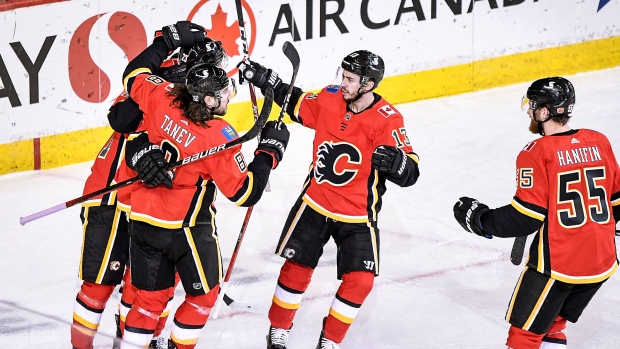Feb 4, 2021
Flames might have found another dominant defensive pairing
For years in Calgary, the defensive duo of Mark Giordano and T.J. Brodie delivered high-end first-pairing performance, dominating the run of play in all three zones. But with Giordano nearing the end of his contract and Brodie in Toronto, Noah Hanifin and Chris Tanev had filled in nicely, Travis Yost writes.
By Travis Yost

For years in Calgary, the defensive duo of Mark Giordano and T.J. Brodie delivered high-end first-pairing performance, dominating the run of play in all three zones.
But as the saying goes, all good things must come to an end. Brodie left the organization this off-season, signing a multi-year deal with the Toronto Maple Leafs. Giordano is still around, but at 37 and one year away from the expiration of his contract, it is a short-term presence.
The concern in Calgary, of course, is how you go about replacing a pairing that was such a prevailing force in the Western Conference? Most of the time this sort of changing of the guard blows up in smoke, if only because it’s usually so hard to replace excellence.
But they appear to have managed that feat in Calgary, where a newly crafted defensive pairing has looked outstanding to start the year.
That pairing features Noah Hanifin (a piece in the bigger Elias Lindholm trade with the Carolina Hurricanes from the 2018 off-season) and Chris Tanev, who signed a multi-year deal this off-season after his contract expired with the Vancouver Canucks.
I’m not sure if this pairing gets traction 20 years ago, but this is an era where coaches are desperate for high-end skating and puck movement from the blueline, and Hanifin and Tanev both have that in spades.
The interesting question when this pairing was enjoined was whether or not they would be capable enough in all three zones. While Tanev has had a lengthy track record of being a stable two-way defender, Hanifin’s defensive numbers have been less encouraging in Calgary and Carolina.
But Hanifin also hasn’t had a partner as trustworthy and reliable as Tanev. Most of Hanifin’s minutes in recent years were spent with Travis Hamonic and Rasmus Andersson, neither of whom are as strong off the puck as Tanev.
What’s happened in the 130 even-strength minutes we have seen with Hanifin and Tanev on the ice this season? It’s been sheer territorial domination – the type of territorial domination that spurs significant offensive production and eases defensive burdens, in large part because so much of the game is being played in the offensive zone.
If we compare shot rates and expected goal rates for this Calgary pairing against other common groupings in the league, you can see just how disparate the performance has been:

Any time you are clearing 50 per cent of the shot share and 50 per cent of the expected goal share (which affirms that the shots being generated are generally coming from dangerous areas of the ice), you are going to achieve long-term success. When you have so many more opportunities than your opponent at scoring on a nightly basis, the numbers eventually win out. That’s what’s happening here, too – the Hanifin and Tanev pairing is getting more than 60 per cent of the shots while on the ice and nearly 70 per cent of the expected goals.
What’s all of that offensive zone control meant for Calgary? It’s meant a sterling goal differential to start the season: the Flames are +4 (5 goals for; 1 against) at even strength. That goal differential, meanwhile, comes in the midst of an ugly shooting slump – the Flames are converting on just 7 per cent of shots with this pairing on the ice to start the season.
It’s an important reminder that territorial dominance pays dividends in many ways. At some point the offensive zone puck luck will turn. In the meantime, any early defensive concerns have been squashed.
Just look at what all of the added offensive zone time has meant for a player like Hanifin over the past couple of seasons, courtesy HockeyViz:

I can’t remember a more incongruent year-over-year shot profile than the early season example of Hanifin. What makes this even more convincing is the pairing is really doing it with three different lines – their most common forward teammate in Matthew Tkachuk is playing with them just 33 per cent of the time.
It’s also a reminder that you don’t need to be an incredibly strong interior defender, exceptional shot blocker, or even world-class skater to be great defensively (though those qualities certainly help). Because at the end of the day, the best off-puck defensive blueliner in the world will never be as good a defender as the one who is capable of ensuring his team always has the puck.
Geoff Ward has struck gold in Calgary. When the scoring surge starts, there’s no telling how big of a goal differential this group can run up.
Data via Natural Stat Trick, NHL.com, Hockey Reference, HockeyViz

